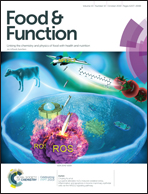The influence of acylation, metal binding and natural antioxidants on the thermal stability of red cabbage anthocyanins in neutral solution†
Abstract
The main red cabbage anthocyanins (pigments) are cyanidin glycosides bearing one or two acyl groups derived from hydroxycinnamic acids (HCAs). Through π-stacking interactions with the cyanidin chromophore, the HCA residues have a deep influence on the color expressed and its stability. In this work, a series of non-, mono- and diacylated anthocyanins were investigated in neutral solution (pH 7 and 8), where the pigments exhibit purple to blue colors. Under such conditions, the gradual color loss observed is a combination of two distinct processes involving the cyanidin nucleus: reversible water addition and irreversible autoxidation. By acidification to pH < 2, the colorless forms stemming from water addition (hemiketal and chalcones) are converted to the red flavylium ion, thereby permitting the selective monitoring of the irreversible contribution. The kinetics of color loss and of true pigment degradation could thus be recorded for each pigment. The influence of iron – cyanidin binding and of antioxidants (caffeic acid, N-acetylcysteine) was also investigated. A complete kinetic analysis combining the anthocyanin colored and colorless forms and the degradation products is provided. Overall, it appears that acylation is critical to color stability. For instance, the nonacylated pigment is rapidly bleached as a result of fast water addition and its iron complex is too unstable to provide protection. By contrast, the diacylated pigments are efficiently protected against hydration but much more moderately against autoxidation, which on the other hand is inhibited by efficient iron binding and addition of N-acetylcysteine. Finally, the diacylated pigments are much more resistant to bleaching by hydrogen peroxide (possibly produced by cyanidin autoxidation) and bisulfite (a common food preservative).



 Please wait while we load your content...
Please wait while we load your content...